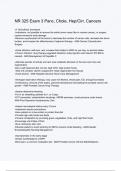NR 325 Exam 3 Panc, Chole, Hep/Cirr, Cancers
-A "de-bulking" procedure
-Indications: not possible to remove the entire tumor mass (like in ovarian cancer), or surgery
causes excessive body damage
-Remove a portion/part of the tumor to decrease the number of cancer cells, decrease the tumor
burden, and increase the effectiveness of adjuvant therapy - ANS-Cancer Cytoreductive
Surgery
-Acute Infection: self-care, rest, increase fluid intake to 2500 mL per day, no alcohol intake
-Chronic Infection: drug therapy pegylated interferon subq injection and ribavirin PO BID is
needed - ANS-Management of Hepatitis C
-Alternate periods of activity and rest: less metabolic demand on the liver and more cell
regeneration
-Eat a well balanced diet, low fat, high CHO, high protein foods
-Take a B-complex vitamin supplement: helps regenerate liver tissues
-Avoid alcohol - ANS-Hepatitis General Home Care Management
-Androgen deprivation therapy, may cause hot flashes, breast pain, ED, and gynecomastia
-Orchiectomy: removal of the testes, prevents testosterone stimulating the prostate cancer cell
growth - ANS-Prostate Cancer Drug Therapy
-Assess abdominal dressing
-Put in an indwelling catheter for 1 or 2 days
-DVT prevention: antiembolism stockings, AROM exercises, avoid pressure under knees -
ANS-Post-Operative Hysterectomy Care
-Assess neurological status every 2 hours
-Implement seizure precautions
-Have patient on a low protein or protein free diet
-Provide high carb foods and fluids
-Prevent constipation by providing green vegetables, fruits, and high fiber foods
-Encourage oral intake of fluid
-Give meticulous skin care
-Educate patient to avoid straining for BM to prevent rectal bleeding - ANS-Hepatic
Encephalopathy Nursing Management
-Asymptomatic in the early stage
-Similar manifestations to BPH
-Bone pain, a common metastatic site - ANS-Prostate Cancer Clinical Manifestations
,-Bitter and metallic taste is common, they have a low tolerance for bitterness
-Substitute poultry, eggs, fish, peanut butter, beans, and dairy for red meat
-Add flavor with herbs, spices, sugar, lemon, and tasty sauce
-Provide plastic utensils instead of metal ones
-Chew mint flavored gum or candy
-Give sweeter food, there is a high tolerance for sweet
-Chilled or cooled food and beverages - ANS-Chemo Side Effect: Change in Taste
-CBC: WBC >10,000
-Amylase and Lipase: to rule out pancreatitis
-Increased serum bilirubin
-ERCP: endoscopic retrograde cholangiopancreatogram, the most useful tool to confirm the
gallstone blocking a bile duct - ANS-Cholecystitis Diagnosis
-Chemo attacks rapidly growing and dividing cancer cells, and doesn't differentiate between
cancer cells and normal cells. Hair follicles, GI, reproductive system, bone marrow all get
affected. - ANS-Chemotherapy Side Effects
-Confirms cancer diagnosis
-Different types of biopsies based on tumor size and location
-After a biopsy, put pressure on the area. The organs are stressed, damaged, and bleeding -
ANS-Cancer Diagnostic Biopsy
-Curative/adjuvant therapy: pre-, post-surgery, and/or combined with chemo
-Palliative radiation is for symptom relief, given only a few times with a low dose -
ANS-Radiation Therapy (RT)
-Done after a completion of cancer treatment
-Used to assess effectiveness of treatment and make decisions for further treatment options
-Used less often now, more used to see the extent of metastasis, but scans are used more
frequently - ANS-Second-Look Cancer Surgery
-Drug therapy is needed
-Pegylated interferon: long-acting weekly subq injection, may cause flu-like symptoms
-Nucleoside and nucleotide analogs are give PO, may cause nephrotoxicity so monitor
creatinine and daily weight - ANS-Hepatitis Management of Chronic Infection
-Drug Therapy: vasopression/Sandostatin, inderal beta blocker
-TIPS: transjugular intraportal shunt, an interventional radiology procedure that reduces portal
HTN, reduces risk for bleeding, and is effective in minimizing ascites, but has many
complications
-Balloon Tamponade - ANS-Bleeding Esophageal Varices Nursing Management
-Establish IV line first for pain control and F&E balance
, -IV fluid infusion of Lactated Ringers
-TPN with lipid infusion and antibiotics
-Morphine through IV for pain
-NPO with NG tube to suction, reduces gastric and pancreatic enzyme secretion
-IV calcium gluconate (10%) for tetany
-PPI: Zantac, Famotidine, Prilosec IV
-Side lying position with HOB at 45 degrees
-Skin and oral care - ANS-Acute Pancreatitis Nursing Management
-Excess alcohol: 32-45%
-Persistant hep C infection: 25%
-Mould toxins (aflatoxins)
-Non-alcoholic fatty liver disease - ANS-Cirrhosis Risk Factors
-Given to improve quality of life, decrease pain, and decrease dyspnea
-Give the patient the minimum dose possible with the least toxic drugs
-Don't use aggressive medication because you don't want the patient to experience side effects,
and their prognosis doesn't warrant large doses of chemo - ANS-Palliative Chemotherapy
-H & PE: primary diagnosis method
-Prostate specific antigen (PSA) slightly elevated
-Digital rectal exam (DRE), preformed after the PSA is tested - ANS-BPH Diagnosis
-Immunization is the most effective method, routine vaccination are 3 doses at 0, 1, 6 months
-Nonimmunized adults are given Hep B Immune Globulin (HBIG) within 24 hours of exposure,
and started on the vaccine - ANS-Hepatitis B Prevention
-Improve nervous system function
-Decrease ammonia levels by manipulating intestinal tract
-Lactulose is the first line drug given, a synthetic nonabsolvable laxative to excrete ammonia
from the intestines, given PO, NG tube, or enema.
-Rifaximin: second line drug given, minimally absorbed antibodies, may combine with lactulose -
ANS-Hepatic Encephalopathy Medical Management
-Increased amylase and lipase
-Increased glucose and triglycerides
-Decreased calcium
-CT scan with contrast is the best imaging
-ERCP - ANS-Acute Pancreatitis Diagnosis
-Increased AST, ALT, and alkaline phosphotase
-Increased prothrombin time
-Increased bilirubin
-Decreased albumin




